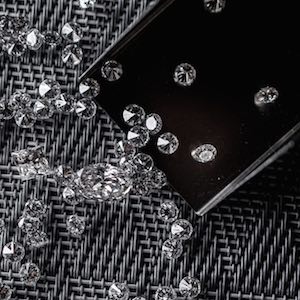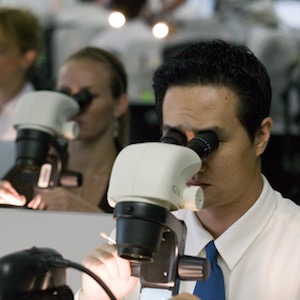
Green Rocks CEO Leon Peres is a man on a mission—one that some might call quixotic but that he thinks will determine the future of the man-made diamond market.
It all stems from the recent change in lab-created diamond grading reports.
The GIA’s new online reports put an asterisk next to the color grade for stones that may have received a “post-growth treatment to change the color.” Last month, the International Gemological Institute also announced that its reports will note whether a created gem is “as-grown [i.e., non-treated] with no indication of post-growth treatment.”
(Neither lab definitively identifies diamonds as treated, as that is a time-consuming process. They just note that the diamond may have been enhanced.)
Now that this information is out there, some wonder if consumers—or retailers—will care. Peres thinks so—though we should point out, he is hardly neutral here, as his company primarily sells as-grown diamonds.
Peres claims that about 90% of the diamonds produced by the chemical vapor deposition (CVD) method are treated by different methods, including HPHT (high pressure, high temperature), LPHT (low pressure, high temperature), and irradiation. Some diamonds grown with HPHT also receive post-growth touch-ups, though there is debate as to whether those can be called treatments. (GIA and IGI both list them as such.)
Peres says that most CVDs look brown when they come out of the growing machine—“almost like a Le Vian Chocolate Diamond.” The treatment makes them whiter, though the stones often have a reddish, pinkish, or, more commonly, a silvery tinge. “I can spot a treated lab-grown just by looking at it,” he says.
The companies that offer untreated stones are generally considered more technologically advanced than others. And given that the lab-grown sector often touts its eco credentials, Peres notes that post-growth treatments require additional energy, on top of the large amounts of power required to create the gemstones in the first place.
Clearly, Signet-owned e-tailer James Allen considers as-grown to be a selling point. Its lab-created diamond page declares: “All of our lab-created diamonds are As-Grown, meaning no post-growth treatment or color enhancement has been performed on them.”
It adds: “CVD diamonds, in most cases, require post-growth treatments to enhance the color from brown or grey to white or colorless, rarely resulting in a stone that resembles an earth-created diamond.”
Sue Rechner, the CEO of WD Lab Grown, also sees it as a possible differentiator.
“Our process—both our patents and the proprietary process we put on top of that—put us in a very unique position of not having to treat larger goods to enhance the color,” she told JCK in October. “There’s no question it’s a differentiator that we have this elegant process that creates a more pure product that doesn’t require enhancement.”
(Ironically, even though WD doesn’t treat all its stones, it sued several companies last January for purportedly infringing on its post-growth treatment patents. In the year since, most—though not all—of those suits have been settled, but market sources say that the legal issues temporarily hurt demand for treated CVD on the market.)
Yet, for all the noise around the issue, many consider it a non-factor at the retail counter, as there’s little proof that customers understand what a treatment is, or examine grading reports in such granular detail.
On top of that, lab-grown diamonds are non-natural items. At JCK Las Vegas in 2019, Steve Coe, the CEO of Lightbox Jewelry, expressed astonishment this would even be debated.
“It’s a manufactured product anyway, so it doesn’t matter how many stages are in the manufacturing process,” he said. “If it takes 2 steps or 10 to get to the end result, that’s just part of manufacturing.”
Tal Nudelman, owner of Dazzle Imports, an Atlanta-based lab-grown seller, agrees: “When a natural diamond is exposed to an artificial treatment, that is different from when it’s done to a lab-grown diamond, which is already artificial. Treatment doesn’t affect the performance of the stone, it just improves the appearance of it.”
He notes that the new lab reports just say the diamond may have a treatment, which signals a certain ambiguity. “If the report noted a tinge, that would make more sense,” he says, adding that that would affect the natural diamond market as well.
Still, Peres provided JCK with the numbers of several retailers who said they were leery of selling treated CVD. Their reasons varied.
“I always go for the highest-level product,” Hank Davis, president of Davis Jewelers in Louisville, Ky., says. “The untreated diamonds just look nicer to me. And if you have a product that’s not treated, you can focus on all the good aspects, like, you can get more diamond for your money. It’s just a cleaner deal.
“When you start talking about treatments, you get into murky waters, and we don’t want to swim in those waters.”
He also thinks that since treated lab-growns are more common, they are more of a commodity. “I don’t even answer my phone anymore, because it’s full of Indian companies trying to sell me lab-grown diamonds. With the treated diamonds, it’s like there’s no [price] bottom.”
Zed Mervis, president of Mervis Diamond Importers, a three-store chain based in Washington, D.C., believes it’s a way to stand apart. “There is so much lab-grown out there that you need to differentiate,” he says. “It’s a story, and stories are good. If you are good at telling a story, you can make an argument, make a case.”
As far as whether a treatment needs to be disclosed legally, the Jewelers Vigilance Committee (JVC) says the rules aren’t clear—though any kind of irradiation treatment is subject to oversight by the Nuclear Regulatory Commission.
“Under the [Federal Trade Commission] guides, treatments that significantly affect the value of the stone must be disclosed to the consumer,” says Sara Yood, JVC senior counsel. “Post-manufacturing treatment might fall into that prong of the treatment disclosure requirement. Certainly, HPHT treatment of natural diamonds does, and I see this treatment functioning in exactly the same way for the laboratory-grown diamond.”
For the moment, the FTC hasn’t ruled on this topic—and Yood isn’t sure how it would come down. “In general,” she says, “I am always going to weigh in on the side of disclosure.”
Peres argues that whether or not individual sellers are disclosing treatments, the labs are—and that will make the difference.
“Before the information on treatments wasn’t available,” he says. “Now, the genie is out of the bottle. When consumers see an asterisk next to the color grade on their report, they are going to ask questions.”
(Photo courtesy of Green Rocks)
- Subscribe to the JCK News Daily
- Subscribe to the JCK Special Report
- Follow JCK on Instagram: @jckmagazine
- Follow JCK on X: @jckmagazine
- Follow JCK on Facebook: @jckmagazine






